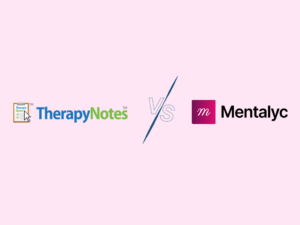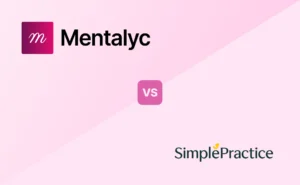Do you ever feel lost in a sea of medical billing codes? As a mental health professional, it’s critical to grasp the codes to provide the best treatment for your clients. One of the most common codes you’ll encounter is F33.2 – recurrent severe major depressive disorder without psychotic symptoms. With over 300 million people worldwide affected by depression, if you’re not currently treating clients with this disorder, you will someday soon. Let’s face it: depression can be all-consuming and isolating.
By staying up-to-date with the latest developments surrounding F33.2 and obtaining a deeper understanding of it, you’ll be better positioned to positively impact the lives of those battling recurrent major depressive disorder. Your commitment to continuous learning and compassionate care means your clients receive the help they need to heal and flourish. This guide will help you explore F33.2, discuss recent changes, determine if a client meets the criteria, and answer frequently asked questions about this debilitating condition.
ICD-10 code: F33.2 – Recurrent Severe Major Depressive Disorder Without Psychotic Symptoms
F33.2 in the American ICD-10-CM system (effective October 1, 2023) is a specific code used for billing purposes. It signifies a diagnosis of Major Depressive Disorder, Recurrent Severe Without Psychotic Features. Remember that international versions of ICD-10 may use different codes for this specific diagnosis.
What Are ICD-10 Codes and Why Are They Important?
The International Classification of Diseases (ICD) is a diagnostic coding system created by the World Health Organization (WHO) to classify and code all diseases and health problems. The 10th revision, ICD-10, includes codes for mental and behavioral disorders. As a mental health professional, using ICD-10 codes is essential for diagnosing clients, billing insurance companies, and tracking treatment.

New! Transfer your notes to EHR with a single click. No more copy-pasting.
Depression: More Than Feeling Blue
Depression is a severe medical condition that negatively impacts how you feel, think, and act. It causes sadness, hopelessness, and a lack of interest in activities you used to enjoy. Major Depressive Disorder (MDD) and Persistent Depressive Disorder (PDD) are two of the most common types of this disorder.
The Differences Between Major Depressive Disorder and Persistent Depressive Disorder
Major Depressive Disorder
It’s essential to understand the differences between MDD and PDD, even though they both involve feelings of sadness. A person may be diagnosed with MDD if they experience one or more major depressive episodes. An episode is at least two weeks in which a person experiences a range of symptoms related to depression, such as:
- Feelings of worthlessness or guilt
- Difficulty concentrating or making decisions
- Recurrent thoughts of death or suicide
Experiencing depressive episodes can be overwhelming and have a negative impact on your daily life. They can interfere with your work, study, eating habits, and sleep. MDD is characterized by intense sadness, hopelessness, and loss of interest in activities that used to bring joy.
The good news is that these episodes can be temporary and might improve even without treatment. In this case, ongoing treatment and monitoring are necessary to prevent relapse and manage the condition.
Persistent Depressive Disorder
On the other hand, PDD, or dysthymia, is characterized by sadness, hopelessness, and a depressed mood that persists for most of the day, more days than not, for at least two years. While less severe than MDD episodes, these symptoms can cause significant distress or impairment. The depression may vary in intensity but is always present in the background. Treatment for PDD often requires a long-term approach to achieve any remission of symptoms. Some individuals may experience “double depression,” where dysthymia worsens into MDD.
Symptoms may include:
- Low self-esteem, self-criticism, lack of motivation
- Avoidance of social activities
- Becoming rapidly angry, annoyed, or impatient.
The key difference to remember is that MDD causes severe episodes of depression, while PDD results in a chronic low-grade depression that persists for years. Appropriate diagnosis and treatment are essential to managing conditions and improving the quality of life for your clients.
Putting it All Together: Understanding the Criteria for F33.2
The code F33.2 indicates that the client is experiencing a severe episode of major depression without psychotic symptoms. If the patient has experienced multiple episodes with periods of remission, the “recurrent” specifier is added to the diagnosis. To be diagnosed with F33.2, the patient must meet the same diagnostic criteria as MDD, which requires at least five out of nine symptoms.
Let’s look closer at the essential elements of F33.2, which will help you determine if your client meets the necessary criteria.
- Recurrent Episodes: F33.2 entails the presence of two or more major depressive episodes occurring at different times. These episodes should be separated by at least two consecutive months without any depressive symptoms.
- Severe Depression: The severity of depressive symptoms must be significant, causing marked distress and impairment in daily functioning. Clients may experience hopelessness, worthlessness, pervasive sadness, and loss of interest in previously enjoyed activities.
- Absence of Psychotic Symptoms: F33.2 is characterized by the lack of psychotic symptoms such as hallucinations or delusions. Psychotic features, if present, would lead to an alternative diagnosis.
- Duration and Impairment: For a diagnosis of F33.2, the depressive episodes should last at least two weeks. Additionally, these episodes should cause notable distress or functional impairment in various aspects of the client’s life, such as work, relationships, or self-care.
It is crucial to remember that diagnosing F33.2 requires a comprehensive evaluation, including a thorough examination of the patient’s symptoms, medical history, and any underlying factors. Collaborating with patients throughout the assessment process empowers them and promotes open communication.
By understanding and applying the diagnostic criteria for F33.2, you can make accurate diagnoses, develop personalized treatment plans, and provide essential support to individuals who suffer from recurrent severe major depressive disorder without psychosis. Remember that your expertise and compassionate care guide your patients toward healing and well-being.
Changes From DSM-5 to DSM-5-TR Related to Major Depressive Disorder
The Diagnostic and Statistical Manual of Mental Disorders, Fifth Edition, Text Revision (DSM-5-TR) introduced minor changes to the criteria for diagnosing MDD, and the changes made provide only clarification. One of the most significant changes is that the manual no longer excludes bereavement or grief reactions from a depression diagnosis. Previously, normal grief reactions were not diagnosed as depression for up to two months.However, the DSM-5-TR now acknowledges that grief can trigger or worsen symptoms of depression, and a diagnosis can be made as early as 2-4 weeks after a loss in some cases.
Another meaningful change is that the DSM-5-TR has added guidance to help differentiate a manic or hypomanic episode from the effects of substance use or medication. The DSM-5-TR clarifies that symptoms must not be caused by the physiological effects of a substance or drug to qualify for a diagnosis of bipolar or related disorder. This helps prevent over-diagnosis and ensures proper treatment.
Additionally, the DSM-5-TR has added more specifiers to capture the severity, course, and other features of depression that can affect prognosis and treatment planning. For instance, “with mixed features” can be specified when symptoms of depression and mania are present nearly every day during the most recent episode of depression. Identifying the presence of catatonia, anxious distress, or psychosis can also assist in selecting suitable treatment options.
These changes may appear minor, but they significantly impact the diagnostic criteria for MDD. They reflect advances in research and clinical experience and aim to reduce ambiguity, capture important nuances that affect outcomes, and promote accurate diagnosis and treatment for people with depression. By understanding these updates, clinicians can continue to provide the best possible care for clients suffering from depression.
As mental health professionals, we can make a real difference in people’s lives. We can accurately diagnose and treat our patients by staying up-to-date with the latest updates and understanding the ICD-10 coding system. Proper care can manage conditions like F33.2; recognizing severe depression is crucial. Although mastering the diagnostic criteria and codes may seem daunting, they give us a shared language to comprehend better what our patients are going through and how we can best support them. The more we learn about the complexities of conditions such as depression, the more confident we can be in positively impacting the lives of those we serve.
Living in a constantly changing world can make coding complex, timely, and a challenge to keep up with. Thankfully, incorporating advanced tools like Mentalyc can significantly ease the burden by aiding with updates, navigating complexities, and upholding best practices. This frees up valuable time for professionals to focus on clients. Ultimately, prioritizing coding knowledge empowers professionals to improve lives through informed diagnosis and treatment. The more they understand, the better equipped they are to make a positive impact. Register today for your complimentary trial!
FAQ: Your Top Questions Answered About F33.2 and Using ICD-10 Codes
What is recurrent major depressive disorder?
Recurrent major depressive disorder means you experience multiple episodes of major depression over your lifetime. Unlike persistent depressive disorder, a chronic low mood, recurrent major depressive disorder involves episodes of severe symptoms that significantly impact your ability to function, followed by periods of remission. The episodes must last at least two weeks to meet the criteria for a diagnosis.
What’s the difference between F33.2 and persistent depressive disorder (dysthymia)?
F33.2 refers to recurrent severe episodes of major depression, while dysthymia is chronic, milder depression. Someone with F33.2 experiences episodes of severe symptoms interspersed with periods of remission. Dysthymia involves ongoing, persistent symptoms for years.
Treatment for F33.2 may include medication, therapy, lifestyle changes, or a combination. The key is managing symptoms, preventing relapse, and maintaining remission and good quality of life between episodes. With proper treatment and self-care, people with recurrent major depression can live healthy, fulfilling lives.
What’s the difference between F33.1 and F33.2?
F33.1 is for a single major depressive episode. F33.2 indicates the patient experiences recurrent episodes, two or more separate periods of symptoms. Recurrent episodes typically require long-term treatment like medication or therapy to prevent relapse or worsening symptoms.
Do I have to specify the number of previous episodes to use F33.2?
No, you do not need to specify the number of previous episodes. You only need to note that the current episode is a recurrence, meaning your client has experienced at least one prior episode of major depression in their lifetime to warrant the F33.2 diagnosis.
However, using F33.2, in particular, signifies your client would benefit from treatment to prevent future recurrent episodes and achieve long-term remission and recovery.
Why is “recurrent” specified?
Mentioning recurrent episodes is essential because it often indicates a more severe and persistent form of the disorder that may require ongoing treatment to prevent relapse. Patients with recurrent MDD have a high risk of experiencing future episodes, so maintenance treatment such as medication or therapy is usually recommended.
How did the criteria change from DSM-5 to DSM-5-TR?
The diagnostic criteria for major depressive disorder did not change significantly from DSM-5 to the updated DSM-5-TR. Some wording was revised for clarity, but the symptoms and episode duration required for a diagnosis remain the same. The recurrent specifier also continues to indicate a separate diagnosis.
Disclaimer
All examples of mental health documentation are fictional and for informational purposes only.
Why other mental health professionals love Mentalyc

“It takes me less than 5 minutes to complete notes … it’s a huge time saver, a huge stress reliever.”
Licensed Marriage and Family Therapist

“By the end of the day, usually by the end of the session, I have my documentation done. I have a thorough, comprehensive note … It’s just saving me hours every week.”
CDCII

“It’s so quick and easy to do notes now … I used to stay late two hours to finish my notes. Now it’s a breeze.”
Licensed Professional Counselor

“Having Mentalyc take away some of the work from me has allowed me to be more present when I’m in session with clients … it took a lot of pressure off.”
LPC






